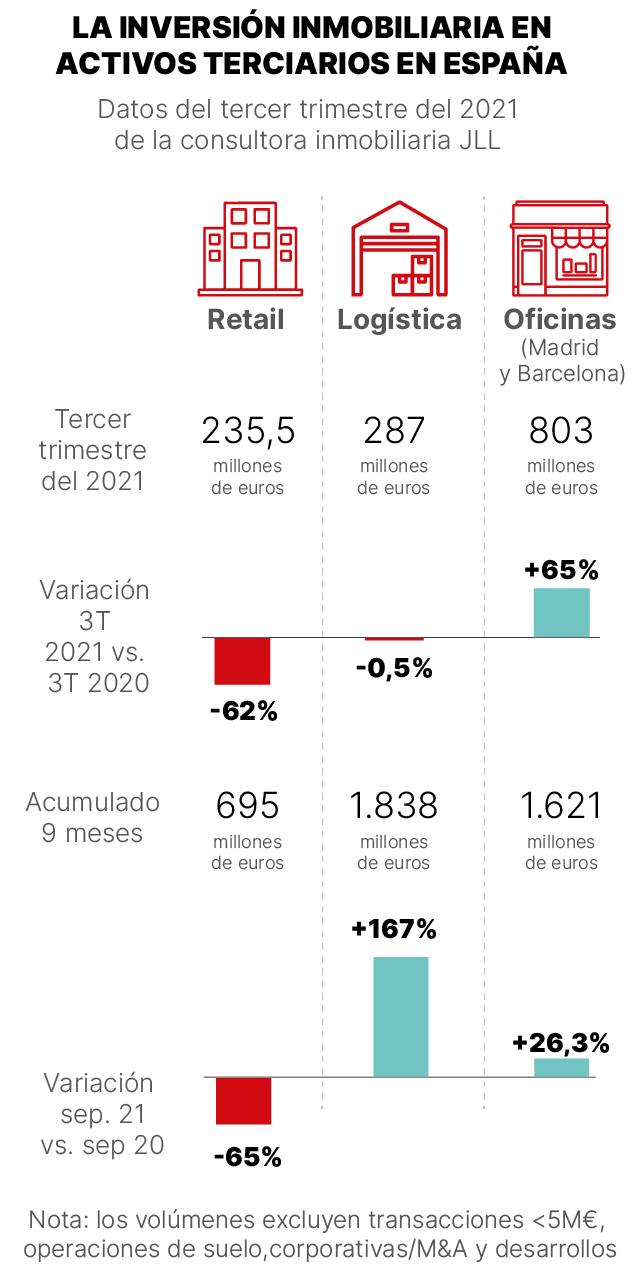-
Investor appetite is concentrated in the logistics segment, driven by e-commerce
In all crises there are winners and losers. In the real estate sector, for example, the stoppage caused by Covid-19 has generated important differences in the tertiary segment, which includes assets such as commercial premises, offices, garages or warehouses.
The worst unemployed have been the commercial premises. “Retail was already suffering before the pandemic and this has only made the situation worse”, he comments Pedro Abella, Director of the Executive Program for Real Estate Business Management at IE Business School. The market analysis for this type of property coincides in pointing out that they will continue to operate, especially those that are well located or dedicated to food. But, in general, “they must reinvent themselves with new models, which we still do not know, but which will surely be based on experience and online purchases in store,” he adds.
Offices are also being reconverted, although they have suffered less from pandemic stakes, especially those located in large business enclaves. The Socimi Merlin Properties, one of the most important listed real estate companies and the main operator of offices in Spain, with 1,900 corporate tenants, has reported an increase in occupancy. In the first nine months of the year they have registered more than 200,000 square meters contracted in offices, marking a “historical record” for the company, says its director, Fernando Ramirez. His explanation is that “the footprint is not changing, but the ways of consuming that space.” “The square meters remain the same: even though a percentage of the workforce is sent to telecommute, the rest of the space is used to separate people”, he details.
In addition, flexible spaces are growing, such as ‘coworking’. “They are having a very large growth because they are well adapted to very fast demands,” says Ramírez.

The one that gives “more joys”
And if there is a winner after these months, that is the industrial and logistics segment. “It is the jewel in the crown”, says the director of Merlin Properties. Encouraged by the impulse of ‘ecommerce’, in this segment “everything that is put on the market is sold at full speed”, he acknowledges. And he adds: “The market is boiling and with growth in price, occupancy … The numbers are excellent and right now it is the category of assets that is giving the most joy.”
In this context, What are real estate companies doing? Up to 64% have chosen to maintain a buying strategy in 2021 and expand their portfolio of assets, compared to the 40% who had this intention in 2020, according to the EjePrime and IE Business School ‘Barometer’. And the figures for now account for this interest. In the second quarter of the year, accumulated investment in ‘Commercial Real Estate’ (which includes the office, logistics and retail sectors) amounted to 2,265 million euros, which represents an increase of 796% compared to the same quarter of the year earlier, when all of Spain was confined to his home, according to data from the international real estate consultancy JLL.
If after this mid-year volume the firm was already talking about the “beginning of the recovery”, the numbers for the third quarter indicate stability: during the first nine months of the year, the money allocated to the office, logistics and retail sectors rose 5% year-on-year and amounted to 4,270 million euros. Of this amount, 1,368 million were made between July and September. For the calculation, JLL takes into account the office areas throughout Spain, (not just Madrid and Barcelona), with volumes that exclude transactions of less than 5 million, land operations, corporate / M & A and developments.
And the private investor? “Although it is true that small investors tend to be more residential, we are also perceiving that they are becoming interested in the opportunities offered by this type of product,” he says. Gonzalo castro, Director of Retail Sales at Solvia. As this expert explains, they are detecting “an active and interested demand in buying to invest, which shows that the investor trusts the returns that he can achieve with the real estate product, which continues to be very attractive.”
¿Sale rentable?
With data corresponding to the third quarter, investment in offices and commercial premises is even more profitable than in housing, according to the Idealista real estate portal. Buying an office for its subsequent rental offers an average gross return of 11.4%, compared to 11.2% in the same period of 2020. In turn, commercial premises present an average return of 9.4%, very similar to the 9.3% registered a year ago. In the case of housing, the average profitability has fallen from 7.9% in the third quarter of 2020 to 7% in the same period this year. The drop has been greater for garages, which rented 6.3% in September 2021, compared to 8.4% 12 months ago.
Related news
However, from Merlin they remember that Not only do you have to look at profitability, but also the ‘yield’, which also takes into account the price at which the asset is acquired. “Is a ‘yield’ of 4% bad or good? It always depends on what you buy. An office building in Diagonal with a ‘yield’ of 4% is fine. And an 8% profitability in Diagonal is impossible, you have to go to the secondary market or to Terrassa “, says Fernando Ramírez.
Looking for commercial premises at street level for sale in Idealista, in Barcelona and Madrid, the cheapest in Barcelona is in El Carmel and costs 27,000 euros, with an area of 30 square meters, while the most expensive is in La Nova Esquerra de l’Eixample at a price of 7.425 million for two floors and 2,759 square meters. In Madrid, the cheapest is located in Quintana (50 square meters for 25,000 euros) and the most expensive, in Chueca, costs 19.5 million and 510 square meters. “There is a diversity of investment sizes in tertiary assets and, therefore, there may be investments for each pocket,” concludes Pedro Abella.
Reference-www.elperiodico.com